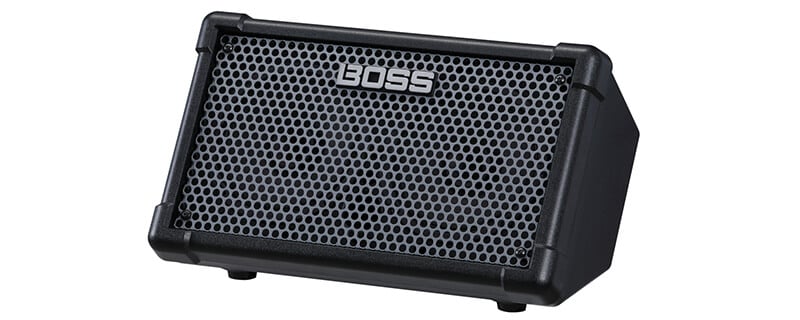Clocking in at 10 watts, the two 6.5” speakers of the new Boss CUBE Street II Amp are nicely paired, and as far as overall volume goes, this is perfect for street/subway performance or a small room situation. At high volume levels, there’s plenty of clarity and headroom, however if it’s running off of eight AA batteries, it might affect the longevity of the battery life. However, there is an ECO mode that drops the battery draw for longer performance time, at a reduced volume. A power supply is included as well, allowing the use of standard AC power. The angled design of the enclosure is enough to project sound to an audience, as well as act as a monitor if placed behind or in front of the performer, without the sound filtering through a vocal mic, and creating unwanted feedback.
The guitar side is pretty packed, with various amp variants — three for an acoustic guitar, and four options for electric guitar, as well as an option to connect a microphone/transducer. A three band EQ, volume, reverb, as well as a combo chorus/delay functionality is available for tonal shaping and processing. The clean tones are quite nice, especially with single coils. It won’t out-deluxe your Fender black panel, but the distorted and overdrive sounds are passible across the board.
For acoustic players there are three modes, basically with three preset EQ curves for either normal, wide, or bright sounds. These make sense to allow a player to quickly tune the amp to their instrument. There is an Acoustic Sim mode, allowing guitar players to plug in an electric guitar and get acoustic sounds. This was the only guitar sound that was ‘meh.’ We tried single coils, humbuckers, and it’s just not cutting it. The clean amp sound had far more dynamics and fullness. Using a real acoustic brought better results; plugging in our PRS SE acoustic, it sounded great, and we preferred the wide setting option to add some extra bottom end.
On the Microphone/instrument side of things, signal input is done via a combo XLR/ ¼” jack, and has a selector for either a mic or instrument level. With a 3-band EQ, volume and reverb there’s plenty of control over overall sound and ambience.
Singers will appreciate the harmony feature, allowing the user to add in unison, as well as additional voices from 3rds, 4ths, 5ths & 6ths. The source key can be set manually or adjusted incrementally. It won’t land you in Beach Boys territory, but can help expand a singer’s range. It stops short of being un-natural and synthetic, it’s more of an enhancement. The Harmony function can also be controlled by an external footswitch.

Looping has been perfected by Boss, and there’s one included in the unit. Press the record button, and it’s ready to go. When it hears the first bit of audio, it starts recording, allowing for hands (and feet) free operation.
Boss also has an app for managing the amp via a smartphone, covering features not on the amp’s panel such as noise suppression on both inputs. The reverb options open up a lot more on the mic/XLR side, with access to Plate, Room & Hall types, and the harmony section covers chorus, phaser, flanger, tremolo and touch wah, and allows more options on the harmony selections.
Overall, it’s quite a potent, yet lightweight all-in-one sound system that is easy to use, and has useful extras such as the harmony and looping functions built in. The big issue is to get the most out of those extra features requires a few extra purchases, as the Bluetooth adapter is $50, not to mention a pair of footswitches for full looping and harmony control.
PROS:
All in one, good guitar sounds, looper, harmony functions, excellent app management.
CONS:
players might need additional footswitches to fully utilize looping and harmony functions. Acoustic sim for electric is meh.
STREET PRICE:
$349
